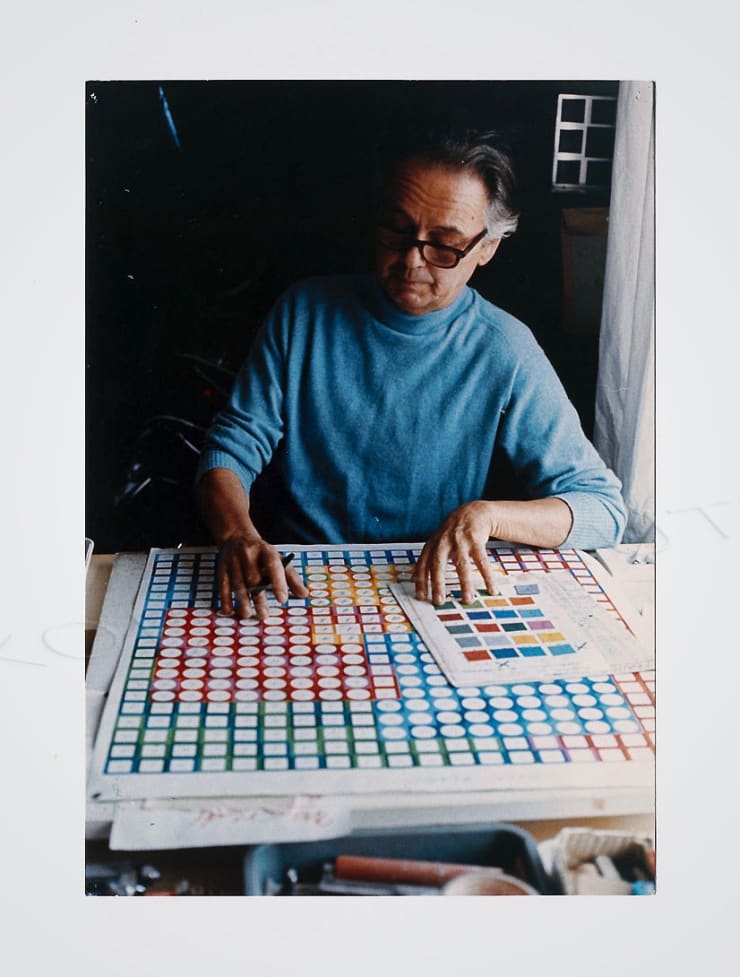Victor Vasarely
Born in the Hungarian city of Pécs, April 9th, 1906, Victor Vasarely is best known for his prominent role in establishing the art movement known as Op Art, or Optical Art. Vasarely spent his youth in Hungary before moving to France, where he spent most of his career as an artist. He died in Paris at the age of 90 in March of 1997.
Art historians credit Vasarely with painting some of the earliest examples of Op Art. In fact, one of his most famous works, Zebras, was painted in 1937, decades before the establishment of the movement.
Early in life, Vasarely’s interests leaned toward the sciences. The artist chose Medical Studies as his focus at Budapest University prior to his making the decision to pursue art. Indeed, Victor Vasarely works demonstrate the intertwined nature of the artist, intriguing us because they are indeed the merging of science and art − with the biological nature of the viewer’s mind providing the kinetic motion within the work.
Vasarely’s formal art training included two years at the Muhely Academy in Budapest. The artistic teachings of the Muhely Academy were based upon those taught and publicized by the Bauhaus school in Germany. Revolutionary Bauhaus concepts that have left far-reaching and indelible imprints on architecture and design around the world can also be recognized within the geometrical works of Victor Vasarely.
Early Victor Vasarely graphic works include chess boards, his famed zebra series, tigers and harlequin works. All demonstrated early signs of optical art brilliance. Interestingly, following Vasarely’s early graphic period, from 1944-1947, inspired by prominent French artists, Vasarely changed focus, painting abstract art that deviated from his Op Art style. He later referred to this period of experimentation as “being on the wrong track.”
Over the next handful of years, Vasarely was once again on the “right track,” embracing the style that was to become more definitively his. It was during this period, that the artist created Op Art works directly inspired by local geographical influences. Summer vacation at France’s Breton coast inspired his Belles-Isles works, and intrigue with wall tiles at the Denfert-Rochereau metro station in Paris led to his Denfert works.
Vasarely’s 1950’s work was dominated by his black and white kinetic paintings. Undoubtedly, the Victor Vasarely black and white linear compositions and checkerboard manipulations from this era helped fuel the Op art movement, and they continue to serve as iconic representations of the artist’s form. In 1955, Vasarely published his “Yellow Manifesto,” for which he received the critics’ award in Brussels and the Gold Medal at the Milan Triennial.
“Movement does not rely on composition nor a specific subject, but on the apprehension of the act of looking, which by itself is considered as the only creator.”
—From Vincent Vasarely’s Yellow Manifesto
The following period of Vasarely’s career would be closely tied to the unveiling of his Alphabet Plastique, a method for developing works which the artist patented in 1959. The method includes the use predefined units of form and color, essentially creating the equivalent of a programming language for somewhat mechanically creating works – referred to as “serial art.”
Folklore planetaire is the name of the palette that Vasarely presented to the public in 1963.
It was in 1965, when Victor Vasarely was included in the Museum of Modern Art’s exhibition, The Responsive Eye, that the artist’s popularity skyrocketed. This is the time when Vasarely became widely considered a seminal figure in the Op Art movement.
Throughout the 1960’s and following two decades, Vasarely’s optical illusion works included those within the artist’s famed Tribute to the Hexagon (Hommage à l’hexagone), Vega and Gestalt series of works.
Two Vasarely museums have been established in Victor Vasarely’s homeland of Hungary. One opened in 1976 in the artist’s birthplace of Pécs and the other opened in 1987 in Zichy Palace, Budapest.
-

The Influence of Victor Vasarely
May 7, 2019The Pompidou Centre in Paris recently celebrated the life and work of Victor Vasarely, the Grandfather of Op-Art, with an exhibit than spanned the more than five decades of his work. Born in Hungary in 1906, Vasarely dropped out of medical school, at age 23, to study with avant-garde artist, Sándor Bortnyik. Bortnyik was a proponent of the Bahuas philosophy, which emphasized the relationship between art, society, and technology.Read more -

Victor Vasarely and the Chess Board
February 26, 2018Victor Vasarely studied medicine before he studied art. His initial art education, in Budapest, was very traditional, but his scientific mind led him to experiment with colors and optics. Vasarely moved to Paris in 1930, and worked as a talented and successful graphic designer. He credited the intense light of southern France, and the way it affected his vision, with his development of Op Art.Read more -

Victor Vasarely’s Alphabet Plastique
March 28, 2016The French Institute in Budapest is exhibiting the works of Victor Vasarely through June. Born in Hungary, Vasarely moved to Paris in 1930 and became a French citizen in 1959. There was a time, just before and after World War ll, when the work of Vasarely and other abstract artists was banned in Hungary. Vasarely studied medicine before turning his scientific mind to his art. Back in the 1950s, way before the digital age, Vasarely used what he called programmations to create his artwork.Read more -

Victor Vasarely Artwork and Visual Perception
September 28, 2015We don't always see what we think we see. Artists have been translating their visual perceptions of the three-dimensional world onto flat surfaces for about 40,000 years, the time of the earliest cave paintings. Most of us are used to viewing our world in a linear fashion. In America, and other industrialized countries, we build rectangle-shaped houses, with rectangular rooms and rectangular gardens. We have some winding highways, but the roads of our cities and towns are usually formed by grids.Read more






